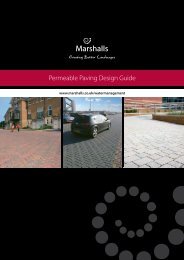You also want an ePaper? Increase the reach of your titles
YUMPU automatically turns print PDFs into web optimized ePapers that Google loves.
16<br />
<strong>Permeable</strong> <strong>Paving</strong> <strong>Design</strong> <strong>Guide</strong><br />
Marshalls Priora – <strong>Permeable</strong> <strong>Paving</strong> Made Easy<br />
Marshalls Priora, the best selling permeable paving system in the UK, is an<br />
ideal SUDs solution. The designs of both the sub-base and the block itself<br />
have been continually developed over the past 10 years to provide a solution<br />
which delivers on all levels in terms of cost, performance and aesthetics.<br />
It is important to acknowledge that a permeable pavement is a<br />
system and not just a paving block; the design of the sub-base is<br />
essential to the system's performance, and allows the pavement<br />
to perform structurally (by supporting the load on the<br />
pavement) and hydraulically (by storing the required amount<br />
of run-off water).<br />
Rainwater falls onto the<br />
surface…<br />
Where it seeps<br />
immediately through the<br />
specially created voids<br />
between the blocks…<br />
Into the specially<br />
designed sub-base…<br />
Where it is stored…<br />
Until it permeates into<br />
the ground…<br />
…or is released into<br />
water courses at a<br />
controlled rate.<br />
each block features a<br />
series of six patented<br />
Priora nibs around<br />
its edge, which<br />
interlock on eight<br />
separate faces in<br />
three different<br />
directions. These<br />
nibs also create<br />
the voids through<br />
which water run-off<br />
percolates into the<br />
sub-base.<br />
The sub-base is<br />
composed of two<br />
different grades of<br />
aggregate. These<br />
are specially<br />
selected to<br />
provide maximum<br />
internal friction<br />
(offering enhanced<br />
stability) whilst also<br />
providing a void<br />
ratio of over 32%<br />
(offering adequate<br />
water storage)<br />
(see page 18)<br />
Marshalls Priora deals with<br />
water Quantity issues by<br />
eliminating pooling<br />
The system improves<br />
water Quality by filtering<br />
the water as it falls<br />
through the sub-base.<br />
It also provides<br />
Biodiversity benefits by<br />
replenishing the water<br />
table at source, which<br />
will maximise ecosystem<br />
services in the area.<br />
A Patented Nib <strong>Design</strong> For Superior Interlock<br />
www.marshalls.co.uk/watermanagement<br />
A key factor in the way a block paved surface behaves is the way in which<br />
each block interlocks with its neighbours. Interlock helps to spread the load<br />
evenly across the area of the paved surface, improving surface stiffness and<br />
reducing pressure on the laying course immediately beneath the blocks.<br />
There are three different kinds of interlock: horizontal, vertical<br />
and rotational.<br />
Vertical interlock refers to the ability of each block to move<br />
against its neighbours on a vertical plane. If the sub-base has<br />
been designed and installed to our specifications, it is unlikely<br />
that this will be a factor in a Priora surface. However, the unique<br />
patented Priora nib improves vertical interlock by increasing the<br />
amount of 'brick to brick' contact. The 6mm aggregate between<br />
the blocks further improves vertical interlock by bridging the<br />
gap between blocks.<br />
Rotational interlock refers to the ability of each block to<br />
rotate against its neighbours on a horizontal plane. This<br />
is where the unique patented Priora nib has a proven<br />
advantage; in laboratory tests at Newcastle’s Rolling Load<br />
Facility (NUROLF), Professor John Knapton discovered that<br />
the Priora nib maximises rotational interlock between<br />
blocks, and can therefore reduce pressure on the laying<br />
course by up to 40% compared to other surfacing options.<br />
Horizontal interlock refers to the ability to move against<br />
its neighbours on a horizontal plane. In all CBP installations,<br />
horizontal interlock is maximised by the geometric shape of<br />
the block. The interlocking nature of the Priora nib reduces the<br />
ability of a block to move horizontally against its neighbours.<br />
This feature can also be enhanced by the laying pattern.<br />
A herringbone laying pattern has been proven to provide<br />
the best possible horizontal interlock which makes it the<br />
recommended style for heavy loading applications.<br />
Professor John Knapton<br />
World Renowned<br />
Structural engineer<br />
"...it's one of the few benefits<br />
of a paver that's not just a<br />
marketing claim - it does<br />
actually have some good engineering behind it"<br />
17



